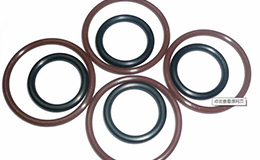首页 > 最新动态 > Super detailed reasons for aging of rubber seals!

Super detailed reasons for aging of rubber seals!
In the petrochemical industry, sealing is very important. Many leakage accidents are caused by seal failure, and seal failure and rubber seal aging are inextricably related. Let’s take a look with the editor below. Seals What are the reasons for aging?
First, look at the signs of aging seals.
①The seal becomes soft and sticky: thermal oxidation of natural rubber, aging of chlorohydrin rubber.
②The seal becomes hard and brittle: thermal oxygen aging of butadiene rubber, aging of nitrile rubber and styrene butadiene rubber.
③ Seal cracks: Ozone aging of unsaturated rubber, photo-oxygen aging of most rubbers, but the crack shape is different.
④ Moldy seals: Biological and microbial rubber aging.
Due to the above reasons, the physical and chemical properties of the seal are directly changed. Changes in the physical and chemical properties of seals: specific gravity, thermal conductivity, glass transition temperature, melting point, refractive index, solubility, swelling, flow variability, molecular weight, molecular weight distribution, cold resistance, air permeability, water permeability, light transmission and other performance changes.
Changes in the physical and mechanical properties of seals: tensile strength, elongation, shear strength, fatigue strength, elasticity, and wear resistance are all reduced.
Changes in electrical properties of seals: changes in electrical properties such as insulation resistance, dielectric constant, dielectric loss, and breakdown voltage, and electrical insulation decreases.
What are the reasons for the aging of the seal?
The role of oxygen: Oxygen undergoes free radical chain reaction with rubber molecules in the rubber, and the molecular chain is broken or excessively cross-linked, causing changes in the properties of silicone rubber products. Oxidation is one of the important reasons for rubber aging.
The role of heat: increasing the temperature can cause thermal cracking or thermal crosslinking of silicone rubber products. But the basic function of heat is activation. Increase the oxygen diffusion rate and activate the oxidation reaction, thereby accelerating the rubber oxidation reaction rate, which is a common aging phenomenon-thermal oxygen aging.
The role of moisture: The role of moisture has two aspects: silicone rubber products are easily destroyed when exposed to rain or immersed in water in humid air. This is because the water-soluble substances in the rubber and ingredients such as clear water are extracted and dissolved by water. Especially under the alternating action of water immersion and atmospheric exposure, the damage of the rubber seal will be accelerated. However, there are some cases where moisture does not damage the rubber and even delays aging.
The role of ozone: The chemically active oxygen of ozone is much higher and it is more destructive. It also breaks the molecular chain, but the effect of ozone on rubber varies with whether the rubber is deformed or not. When used as deformed rubber (unsaturated rubber), cracks in the direction of stress, so-called "stress cracks", will appear. When used as non-deformed rubber, only an oxide film is formed on the surface without cracks.
Cause of light: The shorter the light wave, the greater the energy. The damage to rubber is the higher energy ultraviolet rays. In addition to the direct rupture and crosslinking of the rubber molecular chain caused by ultraviolet rays, the rubber generates free radicals due to the absorption of light energy, which initiates and accelerates the oxidation chain reaction process. Light also has a heating effect on the seal, but with (different heat effect), the light will cause the rubber seal with a high glue content to appear network cracks, the so-called "light external cracks".
Mechanical stress: Due to the viscosity of high molecular polymer, the relaxation process of the sealing ring is too late to complete during the deformation cycle, and then enters the next deformation cycle, which causes the internal deformation of the rubber sealing ring to increase. When the stress is high, the molecular chain breaks and free radicals are generated, which triggers the oxidation chain reaction of the rubber seal molecule; when the rubber seal ring is repeatedly deformed, its mechanical stress will weaken the atomic valence force in the molecular chain of the rubber seal, so Reduce its activation energy for oxidation reaction. The oxidative cracking reaction of the rubber seal ring molecules is accelerated. The reduction of oxidation activation energy is the end of the process of converting mechanical energy into chemical energy in the fatigue process; when the rubber seal is repeatedly deformed, it produces hysteresis, causing internal friction, which causes the internal heat of the rubber material to generate heat, thus accelerating the rubber seal The oxidation chain reaction.
Other effects: There are other electrochemical corrosion, radiation and biological effects.